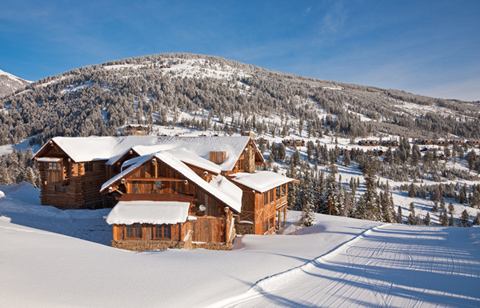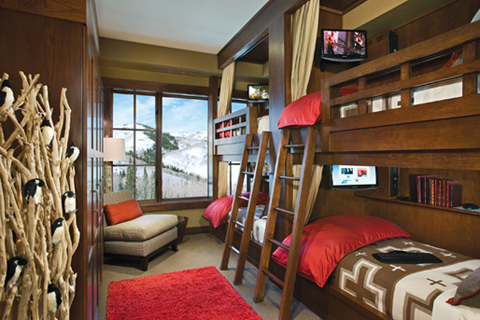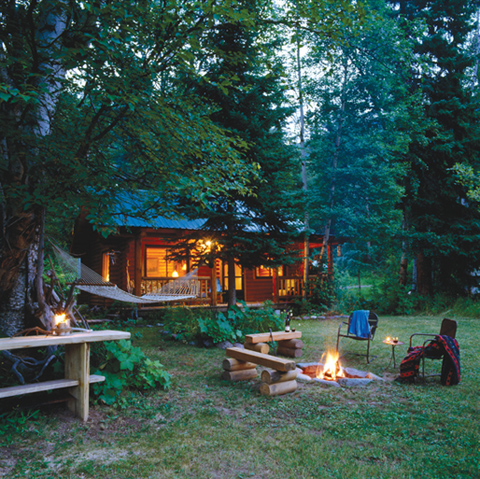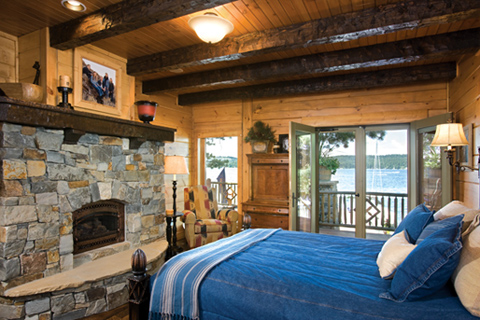When you need to get away from the busy-ness and stress of everyday life, the warmth of a log home and its rustic surroundings can be inviting and comforting. Your ideal retreat could be nestled high in the mountains or settled peacefully along a lakeshore. Wherever your imagination takes you, building your own personal getaway doesn’t have to be a difficult and demanding process.
“Vacation homes tend to be joyful projects,” says Jeremy Oury, president of Kibo Group Architecture, based in Missoula, Montana. “It’s not like it’s something the homeowners have to do. They want to do it, they’re passionate about it, and there’s romance associated with it.”
Here are some factors to consider before building your dream vacation home.
 Lohss Construction/photo by Karl Neumann
Lohss Construction/photo by Karl NeumannThe Perfect Spot
The ideal vacation begins with the perfect setting. First, consider the distance from your primary home versus how frequently you want to use the vacation home. Do you want the vacation home to be within reasonable driving distance or a plane ride away?
“If you plan to use the house infrequently, you probably can withstand a greater distance from your main residence,” says Allen Halcomb, architect and president of MossCreek in Knoxville, Tennessee. “But if you want to go almost every weekend or many times each month, you’ll want to consider the travel factor. You may want to be closer to your vacation home.”
Second, think about how you spend your leisure time. Do you want to ski? Do you want to go hiking, fishing, or hunting? Did you envision relaxing beside the lake with a gripping novel? Perhaps you simply want to be close to shops, restaurants, and cultural events. Whatever your preferences, be sure the location you select offers the right opportunities.
“Make sure the location where you put the home will fit into the lifestyle you’re hoping to enjoy—from warm weather by the lake to a colder climate near a ski resort,” says Mark Moreland, senior vice president at Rocky Mountain Log Homes, in Hamilton, Montana.
 East West Partners/photo by Roger Wade
East West Partners/photo by Roger WadeBudget
Decide how much you are willing and able to spend on the project. Get pre-qualified for a loan so you can establish an accurate budget. As a vacation home, this won’t be your primary dwelling, so take into account how often you intend to use it and what amenities you want to have while you’re there.
“It doesn’t make sense for clients to have a wish list of all sorts of things they want in a home and not be able to afford them,” says Moreland. “The best thing to do is to share the budget in the beginning, and then we’ll ask what you must have to make it work and what you’d like to have. Then we try to fit in as much of that as possible when we design the home.”
Make sure the cost of the land doesn’t take up a significant portion of your overall budget. Halcomb recommends spending no more than a third of the total budget on land. And keep in mind that land prices also include the cost of getting necessities such as electricity, water, and septic service to the property.
“It’s very difficult at times for people to get real with their budget, but it’s critical to do that up front,” Halcomb says. “You’ll be much happier in the end.”
 Lohss Construction/photo by Karl Neumann
Lohss Construction/photo by Karl NeumannThe Right Design
Your vacation retreat doesn’t have to be completely practical, but it is a substantial investment, so make sure it will meet your needs. Work closely with your log home producer, architect, or builder to develop a design that will accommodate your holiday lifestyle and the number of people you might want to share the home with. Do you want a cozy gathering place for two or a retreat large enough to accommodate family and friends?
If the vacation home will ultimately become your primary dwelling in retirement, design the home with aging in mind. Consider placing the master suite on the main level, with handicapped-accessible features. You also may need more closet space, a laundry room rather than a laundry closet, and a complete gourmet kitchen rather than one set up simply for convenience.
A vacation home should be fun, too, so incorporate features that appeal to your personal interests. Oury’s clients have requested unusual and whimsical amenities in secondary homes, including a basement rifle range; a full spa complete with a Jacuzzi, steam room, and cold-plunge pool; and elaborate landscaping featuring a pond with a zip line going into it.
 Photo by Roger Wade
Photo by Roger WadeCare-Free Landscaping
Even if you enjoy gardening and lawn work, you likely won’t want to do yard work while on vacation. Hire someone to maintain the grounds while you’re away and minimize the need for upkeep by using plants native to the region, such as ornamental grasses, ferns, mosses, and wildflowers.
“Most of these vacation locations are fairly natural and rustic,” Oury says. “So you wouldn’t want to bring a bunch of fake landscape elements into a mountain setting or a prairie setting or a lakefront setting. Sticking with native plants enhances the aesthetics.”
While You’re Away
No matter how much you love your retreat, you’ll have to return to the real world eventually. Who will take care of your vacation home while you’re away? Some vacation homes include living space for a caretaker on the property—perhaps in an efficiency apartment over the garage or elsewhere on the site. Other homeowners hire caretakers who live in the area.
“It’s a good thing to get references to verify that they’re trustworthy and will do a good job,” says Wes Pearman, owner of Select Properties Services, Inc., in Highlands, North Carolina, who manages several vacation properties. “We get the house ready for the homeowners’ arrival—or for their guests—such as getting the house cleaned, taking care of any maintenance issues, and making sure the HVAC system is working properly. The homeowners don’t want to be bothered with the everyday details.”
Your builder may be a good resource to help you find a reliable caretaker. If your home is part of a private community or resort, the service may be provided.
Rental Property
If you don’t intend to use your vacation getaway, consider using it as rental property to help pay the mortgage. If that is the case, you’ll want to build the home in a location that has a robust rental market.
“If renting is part of your overall game plan, it’s reasonable to say you should build in a location with an established rental market,” Halcomb says. “You should find a location where people want to come and spend time.”
You also may want to design the home a little differently if you intend to use it as rental property. For example, you’ll need to include an adequate number of bedrooms and sleeping areas, large and open gathering spaces, and amenities such as recreation rooms, spas, and hot tubs. Oury also suggests incorporating a lockout master bedroom to preserve privacy and storage areas to safeguard personal equipment such as toys, hunting gear, and skis.
“The plans for a house that will be rented will be more generic because you’re designing for an unknown person,” Oury says. “You can give the homeowners most of what they want, but they’ll also have to do some things that are generically acceptable for somebody renting a vacation home.”


